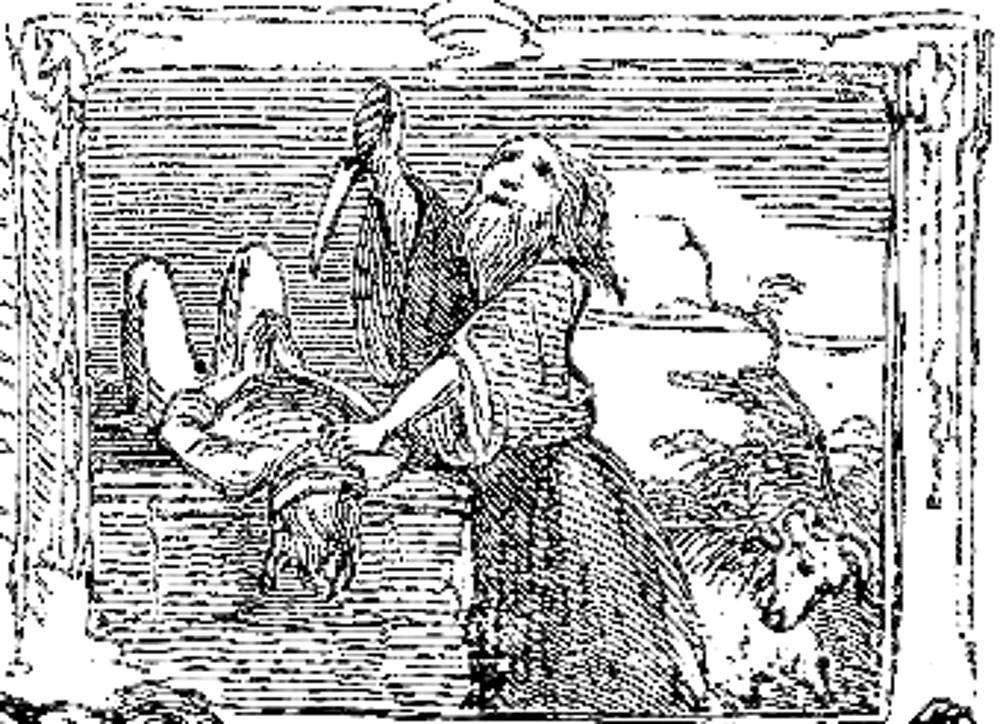
Mr. Chester's Diplomacy by Phiz (Hablot K. Browne). 5 June 1841. Wood engraving dropped into text. Illustration for Dickens's Barnaby Rudge, Chapter XXXII, 118 (seventeenth number). 8.5 cm high by 11.4 cm wide, vignetted. Source: Steig [Return to text of Steig.]
Context of the Illustration: "You have had a cool dismissal, have you?"
"I was about to speak to you from my heart, sir," returned Edward, "in the confidence which should subsist between us; and you check me in the outset."
"Now do, Ned, do not," said Mr. Chester, raising his delicate hand imploringly, "talk in that monstrous manner. About to speak from your heart. Don’t you know that the heart is an ingenious part of our formation — the centre of the blood-vessels and all that sort of thing — which has no more to do with what you say or think, than your knees have? How can you be so very vulgar and absurd? These anatomical allusions should be left to gentlemen of the medical profession. They are really not agreeable in society. You quite surprise me, Ned."
"Well! there are no such things to wound, or heal, or have regard for. I know your creed, sir, and will say no more," returned his son.
"There again," said Mr Chester, sipping his wine, "you are wrong. I distinctly say there are such things. We know there are. The hearts of animals — of bullocks, sheep, and so forth — are cooked and devoured, as I am told, by the lower classes, with a vast deal of relish. Men are sometimes stabbed to the heart, shot to the heart; but as to speaking from the heart, or to the heart, or being warm-hearted, or cold-hearted, or broken-hearted, or being all heart, or having no heart — pah! these things are nonsense, Ned."
"No doubt, sir," returned his son, seeing that he paused for him to speak. "No doubt."
"There’s Haredale’s niece, your late flame," said Mr. Chester, as a careless illustration of his meaning. "No doubt in your mind she was all heart once. Now she has none at all. Yet she is the same person, Ned, exactly."
"She is a changed person, sir," cried Edward, reddening; "and changed by vile means, I believe."
"You have had a cool dismissal, have you?" said his father. "Poor Ned! I told you last night what would happen. — May I ask you for the nutcrackers?" [Chapter XXXII, 117-18]
Steig's Analysis of the Inset Painting: Jacob Sacrificing Isaac

Right: Phiz's placing an image of a well-known Old Testmament story
conspicuously in the background:
A few chapters later another biblical allusion is introduced in the scene where Mr. Chester disowns his son Edward for refusing to marry for money instead of love (ch. 32; Illus. 37). Here there is a large painting of Abraham preparing to sacrifice Isaac (a detail which Thackeray later used, verbally, in a parallel situation in Vanity Fair). (The passage occurs in chapter 24 of Vanity Fair. See my article, on Barnaby Rudge and Vanity Fair. The ironic contrast, of course, is between Abraham's willingness to sacrifice his son out of obedience to God, and Chester's sacrificing his son out of pure selfishness; the father's raised nut-crackers and Abraham's raised knife further emphasize the contrast. [59]
Parallel Scene from the Diamond Edition (1867)

Right: Sol Eytinge, Junior's dual character study which realizes the same
scene,
Image scan, caption, and commentary by Philip V. Allingham. [You may use this image without prior permission for any scholarly or educational purpose as long as you (1) credit the person who scanned the image and (2) link your document to this URL in a web document or cite the Victorian Web in a print one.]
Bibliography
Dickens, Charles. Barnaby Rudge. Illustrated by Hablot K. Browne ('Phiz') and George Cattermole. London: Bradbury & Evans, 1849.
_______. Barnaby Rudge. Ed. Kathleen Tillotson. Illustrated by Hablot K. Browne ('Phiz') and George Cattermole. The New Oxford Illustrated Dickens. London: Oxford University Press. 1954, rpt. 1987.
Hammerton, J. A. The Dickens Picture-Book. The Charles Dickens Library Edition, illustrated by Harry Furniss. London: Educational Book, 1910.
Lester, Valerie Browne. Phiz: The Man Who Drew Dickens. London: Chatto and Windus, 2004.
Steig, Michael. Chapter 3. "From Caricature to Progress: Master Humphrey's Clock to Martin Chuzzlewit." Dickens and Phiz. Bloomington & London: Indiana U. P., 1978. 53-85.
Vann, J. Don. "Charles Dickens. Barnaby Rudge in Master Humphrey's Clock, 13 February-27 November 1841." New York: MLA, 1985. 65-66.
Created 9 October 2002
Last modified 6 August 2020